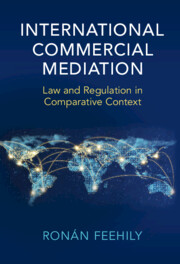218 results
8 - Understanding and Restraining Study Costs
- from Part II - Rethinking Research
-
- Book:
- Rethinking Clinical Research
- Published online:
- 13 March 2025
- Print publication:
- 20 March 2025, pp 160-176
-
- Chapter
- Export citation
Relative Costs and Statistical Power in the Extreme Groups Approach
-
- Journal:
- Psychometrika / Volume 43 / Issue 1 / March 1978
- Published online by Cambridge University Press:
- 01 January 2025, pp. 11-17
-
- Article
- Export citation
Chapter 27 - Business Considerations in Mass Gathering Medicine
-
-
- Book:
- Mass Gathering Medicine
- Published online:
- 11 April 2024
- Print publication:
- 18 April 2024, pp 401-405
-
- Chapter
- Export citation
Chapter Eight - The Award
-
- Book:
- The Principles and Practice of International Commercial Arbitration
- Published online:
- 11 January 2024
- Print publication:
- 01 February 2024, pp 199-213
-
- Chapter
- Export citation
First-episode psychosis intervention programme versus standard care for the clinical management of early phases of psychosis: cost analysis
-
- Journal:
- BJPsych Open / Volume 10 / Issue 1 / January 2024
- Published online by Cambridge University Press:
- 22 December 2023, e17
-
- Article
-
- You have access
- Open access
- HTML
- Export citation
1 - How Economists View Human Behavior
- from Part I - Patients
-
- Book:
- Economics of Healthcare
- Published online:
- 02 November 2023
- Print publication:
- 23 November 2023, pp 3-14
-
- Chapter
- Export citation
4 - The Rising Costs of Dissent
-
- Book:
- Managed Dissent
- Published online:
- 04 May 2023
- Print publication:
- 11 May 2023, pp 84-116
-
- Chapter
- Export citation
Economic evaluation and costs of remote patient monitoring for cardiovascular disease in the United States: a systematic review
-
- Journal:
- International Journal of Technology Assessment in Health Care / Volume 39 / Issue 1 / 2023
- Published online by Cambridge University Press:
- 28 April 2023, e25
-
- Article
-
- You have access
- Open access
- HTML
- Export citation
63 - Economic Analysis of Arbitration
- from Part XIII - Arbitration and Related Fields
-
-
- Book:
- Cambridge Compendium of International Commercial and Investment Arbitration
- Published online:
- 18 February 2023
- Print publication:
- 02 March 2023, pp 1910-1935
-
- Chapter
- Export citation
4 - Ensuring Zero Agricultural Land Expansion into High-Carbon Ecosystems
-
-
- Book:
- Transforming Food Systems Under Climate Change through Innovation
- Published online:
- 19 January 2023
- Print publication:
- 19 January 2023, pp 32-40
-
- Chapter
-
- You have access
- Open access
- HTML
- Export citation
Effectiveness of animal health and welfare planning in dairy herds: a review
-
- Journal:
- Animal Welfare / Volume 24 / Issue 1 / February 2015
- Published online by Cambridge University Press:
- 01 January 2023, pp. 55-67
-
- Article
- Export citation
Introduction: Closed for School, Open for Business
-
- Book:
- Closed for Democracy
- Published online:
- 11 March 2023
- Print publication:
- 22 December 2022, pp 1-28
-
- Chapter
- Export citation
1 - Communicative Efficiency
- from Part I - Different Types of Efficiency in Language
-
- Book:
- Communicative Efficiency
- Published online:
- 03 November 2022
- Print publication:
- 17 November 2022, pp 3-35
-
- Chapter
- Export citation
7 - Conduct and Costs
-
- Book:
- International Commercial Mediation
- Published online:
- 01 September 2022
- Print publication:
- 08 September 2022, pp 162-198
-
- Chapter
- Export citation

International Commercial Mediation
- Law and Regulation in Comparative Context
-
- Published online:
- 01 September 2022
- Print publication:
- 08 September 2022
A good investment: longer-term cost savings of sensitive parenting in childhood
-
- Journal:
- European Psychiatry / Volume 65 / Issue S1 / June 2022
- Published online by Cambridge University Press:
- 01 September 2022, p. S423
-
- Article
-
- You have access
- Open access
- Export citation
Health Services Use and Costs in Individuals with Autism Spectrum Disorder in Germany: Results from a Survey in ASD Outpatient Clinics
-
- Journal:
- European Psychiatry / Volume 65 / Issue S1 / June 2022
- Published online by Cambridge University Press:
- 01 September 2022, p. S422
-
- Article
-
- You have access
- Open access
- Export citation
7 - Evidence on Provider Payment and Medical Care Management
-
-
- Book:
- Seemed Like a Good Idea
- Published online:
- 14 July 2022
- Print publication:
- 28 July 2022, pp 246-273
-
- Chapter
- Export citation
Chapter 62 - Health-Care Organization and Financing
- from Section IV - Principles of Care for the Elderly
-
-
- Book:
- Reichel's Care of the Elderly
- Published online:
- 30 June 2022
- Print publication:
- 21 July 2022, pp 750-760
-
- Chapter
- Export citation
Cost-effectiveness of mirtazapine for agitated behaviors in dementia: findings from a randomized controlled trial
-
- Journal:
- International Psychogeriatrics / Volume 34 / Issue 10 / October 2022
- Published online by Cambridge University Press:
- 19 July 2022, pp. 905-917
-
- Article
-
- You have access
- Open access
- HTML
- Export citation

